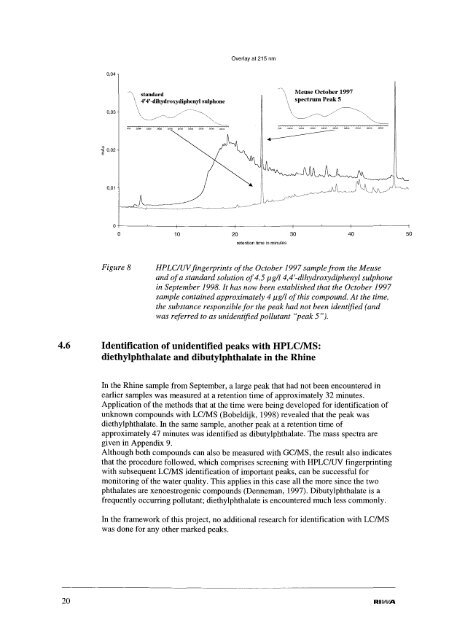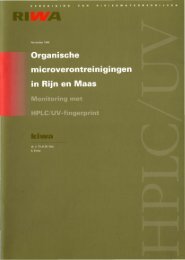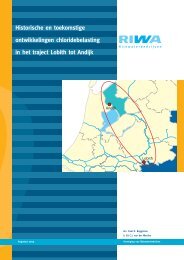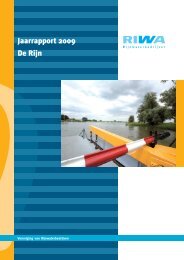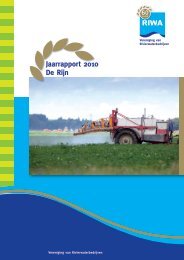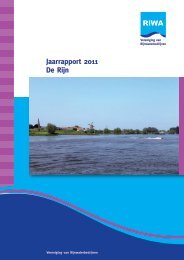Organic micropollutants in Rhine and Meuse a - Riwa
Organic micropollutants in Rhine and Meuse a - Riwa
Organic micropollutants in Rhine and Meuse a - Riwa
Create successful ePaper yourself
Turn your PDF publications into a flip-book with our unique Google optimized e-Paper software.
Overlay at 215 nm<br />
0,04<br />
<strong>Meuse</strong> October 1997<br />
spectrum Peak 5<br />
0,03<br />
~ 0,02<br />
0,01<br />
O+---~-----+---~-----+---~---+---~----+-------'--------1<br />
o 10 20<br />
retention time <strong>in</strong> m<strong>in</strong>utes<br />
30 40 50<br />
Figure 8<br />
HPLC/UVf<strong>in</strong>gerpr<strong>in</strong>ts ofthe October 1997 sample from the <strong>Meuse</strong><br />
<strong>and</strong> ofa st<strong>and</strong>ard solution of4.5 Jlg/l4,4'-dihydroxydiphenyl sulphone<br />
<strong>in</strong> September 1998. It has now been established that the October 1997<br />
sample conta<strong>in</strong>ed approximately 4 Jlg/l ofthis compound. At the time,<br />
the substance responsible for the peak had not been identified (<strong>and</strong><br />
was referred to as unidentified pollutant "peak 5").<br />
4.6 Identification of unidentified peaks with HPLC/MS:<br />
diethylphthalate <strong>and</strong> dibutylphthalate <strong>in</strong> the Rh<strong>in</strong>e<br />
In the Rh<strong>in</strong>e sample from September, a large peak that had not been encountered <strong>in</strong><br />
earlier samples was measured at a retention time of approximately 32 m<strong>in</strong>utes.<br />
Application of the methods that at the time were be<strong>in</strong>g developed for identification of<br />
unknown compounds with LC/MS (Bobeldijk, 1998) revealed that the peak was<br />
diethylphthalate. In the same sample, another peak at a retention time of<br />
approximately 47 m<strong>in</strong>utes was identified as dibutylphthalate. The mass spectra are<br />
given <strong>in</strong> Appendix 9.<br />
Although both compounds can also be measured with GCIMS, the result also <strong>in</strong>dicates<br />
that the procedure followed, which comprises screen<strong>in</strong>g with HPLC/UV f<strong>in</strong>gerpr<strong>in</strong>t<strong>in</strong>g<br />
with subsequent LCIMS identification of important peaks, can be successful for<br />
monitor<strong>in</strong>g of the water quality. This applies <strong>in</strong> this case all the more s<strong>in</strong>ce the two<br />
phthalates are xenoestrogenic compounds (Denneman, 1997). Dibutylphthalate is a<br />
frequently occurr<strong>in</strong>g pollutant; diethylphthalate is encountered much less commonly.<br />
In the framework of this project, no additional research for identification with LCIMS<br />
was done for any other marked peaks.<br />
20 RliliVA


